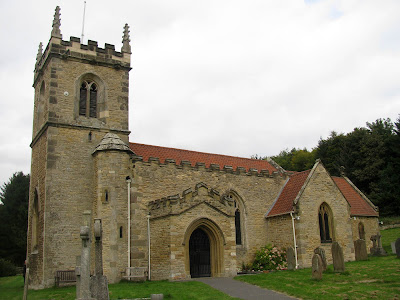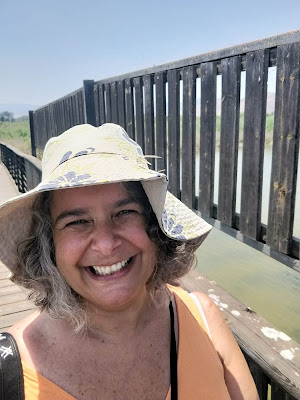Our first port of call was Rudding Park on the outskirts of Harrogate in North Yorkshire, where the wedding was due to take place. We were lucky enough to be staying at the Rudding Park Hotel for a few days. This rather luxurious hotel occupies a Georgian manor on 300 acres of parkland. It was a joy to walk around the surrounding parkland and golf course on the morning of the wedding. The wedding itself was beautiful!
The following day we took a trip to Mother Shipton's Cave and Petrifying Well in Knaresborough. The petrifying well, also known as a dropping well, is the oldest tourist attraction to charge a fee in England and has been in operation since 1630! The water of the well is so rich in sulphate and carbonate that artefacts are put in the well to be "petrified". The place is also associated with the legendary soothsayer Mother Shipton. According to legend, she was born in the cave and grew up around Knaresborough. As she grew older, her prophecies became known throughout England. She foretold the defeat of the Spanish Armada and the Great Fire of London.
The town of Knaresborough is perched high on a cliff above the River Nidd. Our visit to the ruins of Knaresborough Castle offered us an amazing view of the river and railway viaduct, above. The castle was first built by a Norman baron around 1100 and was controlled by various people until it was taken by Parliamentarian troops in 1644 during the Civil War and largely destroyed in 1648. Some of the surviving areas of the castle keep wall bear impact scars left by musket balls fired during the Civil War siege.Then it was time to move on to Hull in the East Riding of Yorkshire, the place where I grew up and where my dad still lives. I thought I pretty much knew the area but when dad suggested a walk in Paull, a sleepy village south east of Hull, on the north bank of the Humber Estuary, I discovered a place I have never been to before. We enjoyed the coastal wetland and the surrounding grassland and farmland and spotted a few birds as we strolled. Another gorgeous new find was Tophill Low Nature Reserve, which is located on the site of an active water treatment works, operated by Yorkshire Water. The reserve consists of two artificial reservoirs and features 12 hides spread across a 300 acre site that flanks the River Hull. It comprises a variety of habitats with grassland, marshes, ponds and woods supporting over 160 bird species across the year. It was a delightful place to visit!
There was time for one more outing before leaving for London. We took a walk through the tiny village of Brantingham. The village has significant historic houses, including Brantingham Hall and Brantingham House, which overlook the duck pond in the centre of the village. A cast iron water pump raised up on a brick platform can still be seen on Spout Hill and a sheep wash, or washdyke, which was used regularly until the 1950s to wash sheep prior to shearing, is situated just beyond the church. The church itself is 12th century in origin and restored by the Victorians in the late 19th century. Unusually, it is not situated in the centre of the village but a little way up a wooded dale, affording it one of the most picturesque settings of any church in the Yorkshire Wolds.
As we left Brantingham I stopped to take a look at the war memorial, above, which was erected in 1922 in memory of 14 local men who gave their lives during World War I. The memorial and surrounding wall were constructed from materials reclaimed following the demolition of Hull's Victorian Town Hall. It has been described as "one of the most lovably awful things in the East Riding". I am not sure I disagree.
Then it was on to London to see our family there, though I always make time for a little sightseeing as well. We joined a Beatles "In My Life" tour run by London Walks and led by Richard Porter, holder of the "Beatles Brain of Britain" title. We saw the film locations for "A Hard Day's Night" and "Help!", the registry office where two of the Fab Four got married and the house where Paul lived with his glamorous girlfriend, actress Jane Asher. It was in that house that John and Paul wrote "I Want to Hold Your Hand". We ended the tour at the legendary Abbey Road studios and crossing, above.
There was time for just one more thing! We booked a slot at The Museum of Brands in Notting Hill. The museum examines the history of consumer culture from Victorian times to the present day. It features over 12,000 original items including household goods, bottles and cans, packaging, sweets, posters, toys and games, all set out in chronological order in the form of a "Time Tunnel". I thoroughly enjoyed looking at brands from bygone years and seeing names that are still recognisable today. It was great fun to see the toys I used to play with in the 70s and the records I listened to in the 80s. Altogether, a wonderful trip down memory lane!
* This post has been shared on Little Things Thursday, Floral Passions, Wordless Wednesday (on Tuesday), Our World Tuesday, Tuesday's Treasures, Pictorial Tuesday and My Corner of the World.


































































































